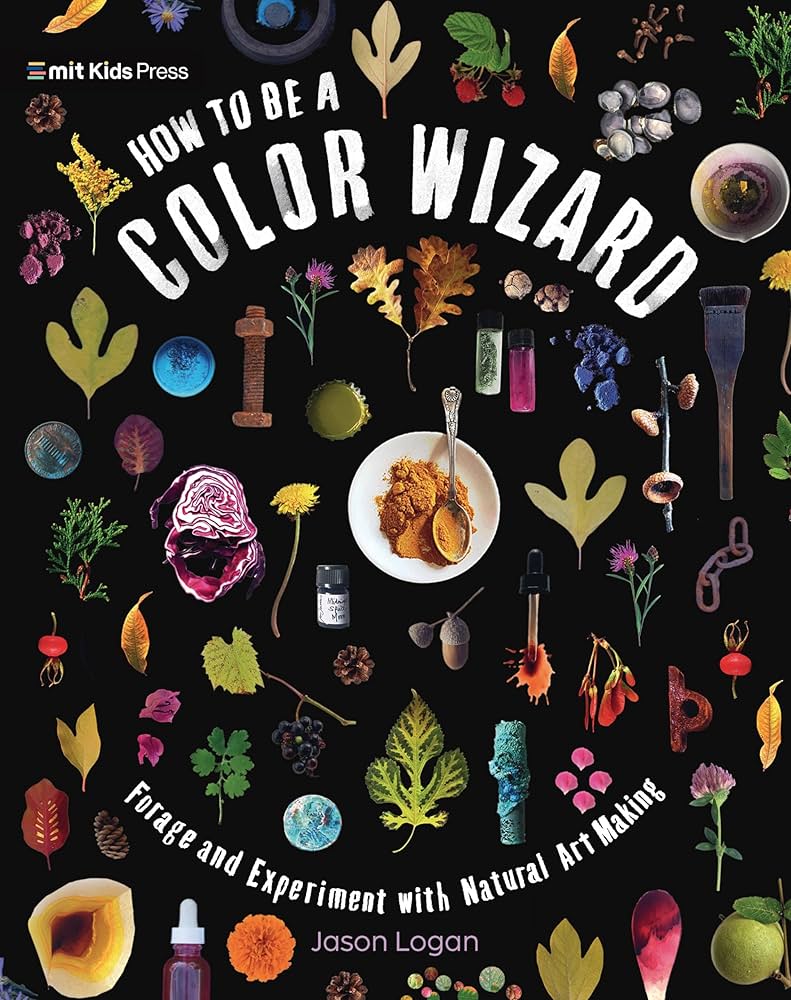How to Be a Color Wizard: Forage and Experiment with Natural Art Making

How to Be a Color Wizard: Forage and Experiment with Natural Art Making
Sap green is created from an amazing and very ancient recipe from the time that ordinary people call the Dark Ages and we wizards call the Glory Days. You know those giant first letters decorated with little vines and figures (and even the occasional snail) that you sometimes see at the beginning of fairy tales? Well, all the good books, called illuminated manuscripts, started like that back in those days, which meant that monks were always running out of the most expensive colours like gold and silver for their lettering. Because sap green becomes a golden green when you get the recipe just right, it was used as a replacement for real gold.
Science and “magic” unite to create art in this book of experiments with colour. The wizard theme is consistent throughout the book, beginning with a quiz which is designed for the reader to determine what kind of wizard they are. Prior to delving into the three main sections of the book, the author presents a list of safety rules and a chart of the symbols that are used for each experiment, indicating the degree of difficulty, whether an adult’s assistance is required, whether the experiment should be conducted outdoors or in a group, and what type of wizard - earth, water, air, fire rainbow - will enjoy it most.
The first section, entitled “Gather”, discusses the materials that colour wizards need to conduct the activities and provides instructions for making a wizard’s notebook. (However, after giving the instructions for a homemade notebook, the author recommends a type of notebook to purchase: “thread-bound with a waterproof hardcover is ideal”. Then why bother with an inferior homemade one?) In this section, “foragers” are encouraged to look for colour in nature. The author tells the story of the mantis shrimp that sees far more colors than humans do. He presents an experiment in which he asks readers to find an interesting area of land, lay a hula hoop down and observe the colours, textures and shapes within the hoop. At the end of the experiment, he asks, “How does it feel to be inside the eyes of a mantis shrimp?” No matter how observant the experimenters are, they will never be able to see objects in the same way that the shrimp can.
Part Two is entitled “Transform”. In this section are recipes for making various colours with spices, vegetables, fruits, acorns, chocolate and copper, to name a few. Though the author states that most ingredients are easy to find, some, like buckthorn berries, might not be available in one’s area, while others require a trip to a specialty store: gum arabic, alum, Erlenmeyer flasks, ink bottles, mortar and pestle and wintergreen oil, to name a few. Some of the creations that kids can make include a purple lava “lamp” from red cabbage, baking soda, cooking oil and Alka-Seltzer, spicy highlighter markers from turmeric, paprika, cinnamon and curry powder, and blue ink from copper, salt and vinegar.
The third section, entitled “Share”, shows ways in which one’s colour creations can be shared with friends. These ideas range from making one’s own posters with potato prints to invite kids to a color block party, to incorporating several of the creations from the second section of the book.
Throughout the book there are several additional text boxes: “Color Hero”, which features scientists and colour theorists, and “True Magic”, which provides trivia related to the topic. Illustrations consist of colour photographs and diagrams. Children featured in the photos appear to be younger than the target audience.
How to be a Color Wizard: Forage and Experiment with Natural Art Making will have a limited audience, and, though there are some interesting activities here, it is unlikely that readers will try them all. Perhaps an art teacher will find a few activities for classroom use, or families will have fun foraging, then creating some unique art work. As mentioned earlier, the wizard theme is consistent throughout the book, but it gets old very quickly, and there is a lot of unnecessary verbiage, particularly in the first section.
A table of contents and an index are included.
Gail Hamilton is a former teacher-librarian in Winnipeg, Manitoba.
